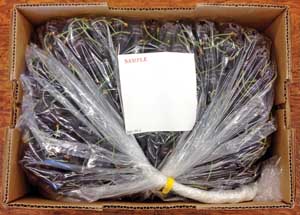
An example of a modified atmosphere package liner. (Courtesy Yan Wang)
Cherry packers have been able to extend the shelf life of cherries for long-term storage and shipping with modified atmosphere packages (MAP).
But it’s important to match the right MAP liner to cherry cultivar, according to postharvest physiologist Dr. Yan Wang.
Just as cherry varieties have different fruit respiration rates, MAP liners vary in their gas permeability.
To select the appropriate MAP, researchers first needed to know the optimum oxygen and carbon dioxide concentrations for maintaining the shipping quality of Pacific Northwest cultivars.
Wang, who’s stationed at Oregon State University’s Mid-Columbia Agricultural Research and Extension Center in Hood River, evaluated seven commercially available MAP liners for their effect on cherry quality deterioration and physiological changes.
In his trial, he used fluctuating temperatures ranging from 32°F to 40°F to simulate temperatures experienced in ocean shipping containers and at export arrivals.
Wang measured cherry respiration rates of Bing, Sweetheart, Coral Champagne, Skeena, and Lapins. He found that for most cultivars, MAP liners that have oxygen rates between 5 to 8 percent and carbon dioxide rates between 10 to 15 percent provided the best results in reducing fruit respiration rates without anaerobic injury.
Such MAP liners maintained skin luster, color, acidity, and flavor, and inhibited bitter taste development. During long-term storage or shipping of sweet cherries, a major postharvest quality issue is the loss of the fruit’s characteristic flavor, resulting in a bland taste.
Among the cultivars Wang studied, he found an exception. “Skeena is unique compared to other cultivars because it has a higher respiration rate and is more susceptible to anaerobic injury, especially during temperature fluctuations,” he reported. “So for Skeena, higher oxygen levels of 8 to 10 percent is needed in the MAP liner to maintain quality without anaerobic injury.”
Core temperature
Wang also learned during his research that fruit core temperature in MAP is critical during ocean shipping.
In Pacific Northwest packing operations, the fruit core temperature at the time of packing is usually 38°F to 45°F, he said.
“Forced-air cooling immediately after packing to reduce the fruit core temperature to about 32°F is extremely important for long distant ocean shipping,” he said.
For MAP cherries held in storage for four to five weeks, fruit firmness and stem quality was best in fruit held at 32°F. Wang says that because of the barrier from MAP and fruit respiration heat, the core temperature of cherries packed at 38°F to 45°F will not reach 32°F during shipping even when that is the temperature of the container.
The storage and shipping life of Pacific Northwest cherries can be extended to one to two months if high-quality fruit with high-calcium content is matched with the right MAP liner, and forced-air cooling brings fruit core temperatures to 32°F before ocean shipping, Wang said. “Fruit quality is significantly reduced if the fruit is not cooled before ocean shipping.” •






Leave A Comment